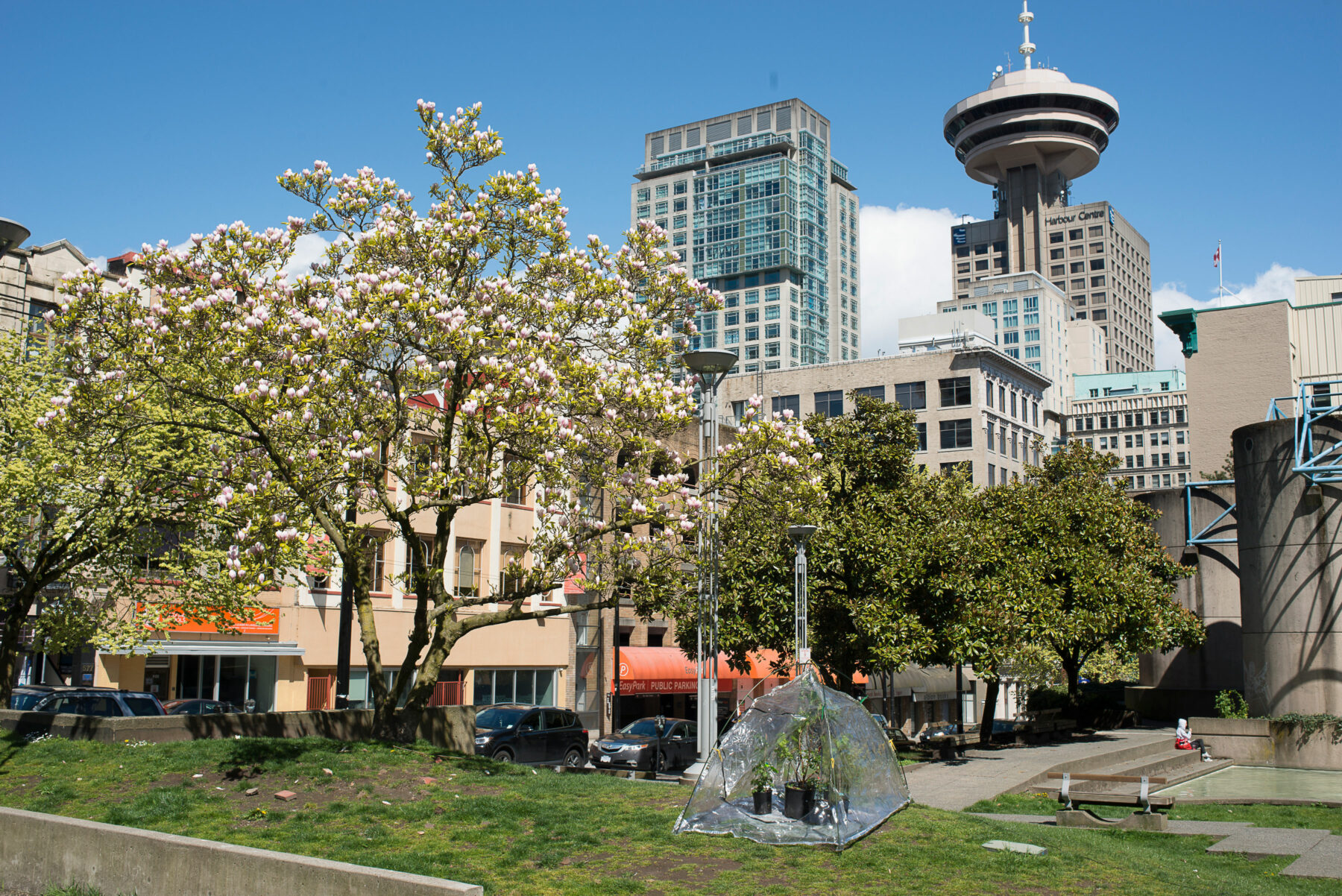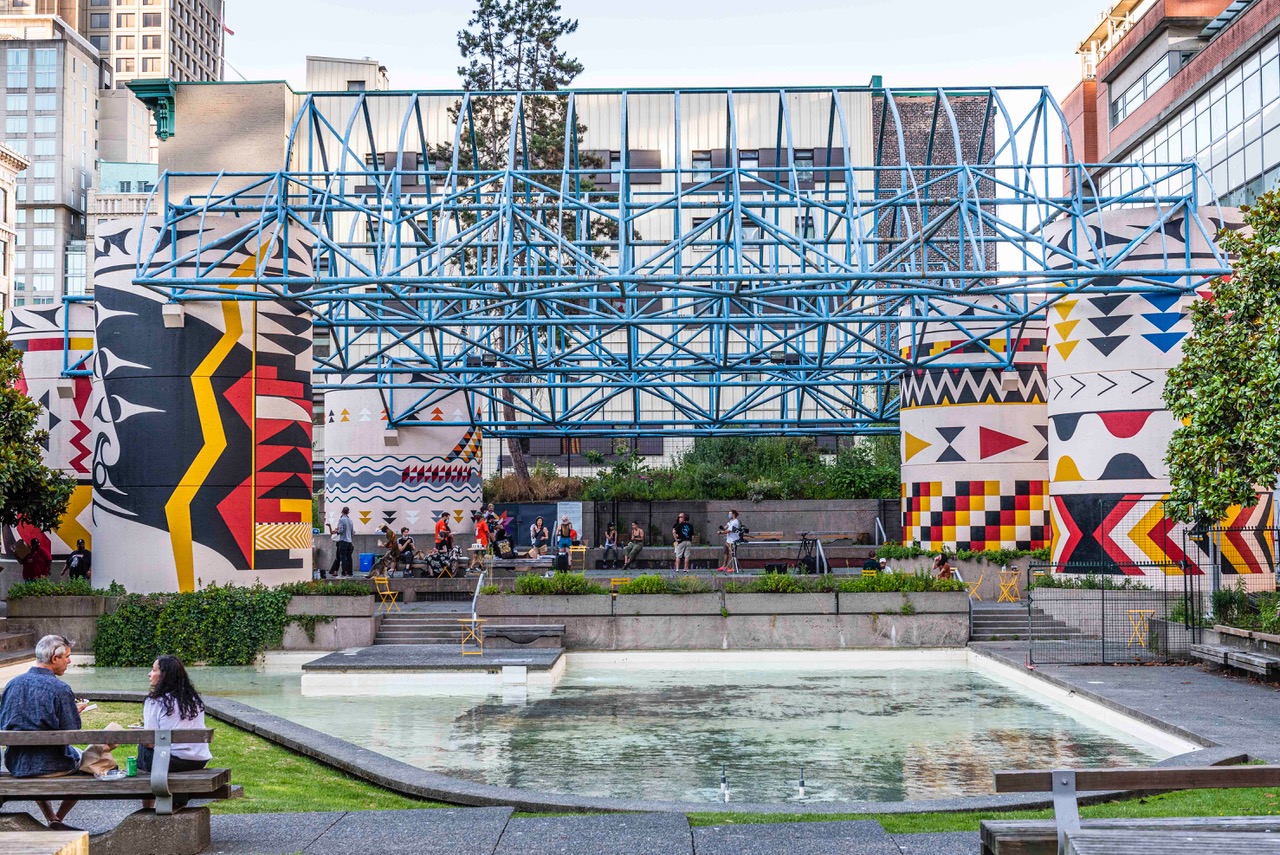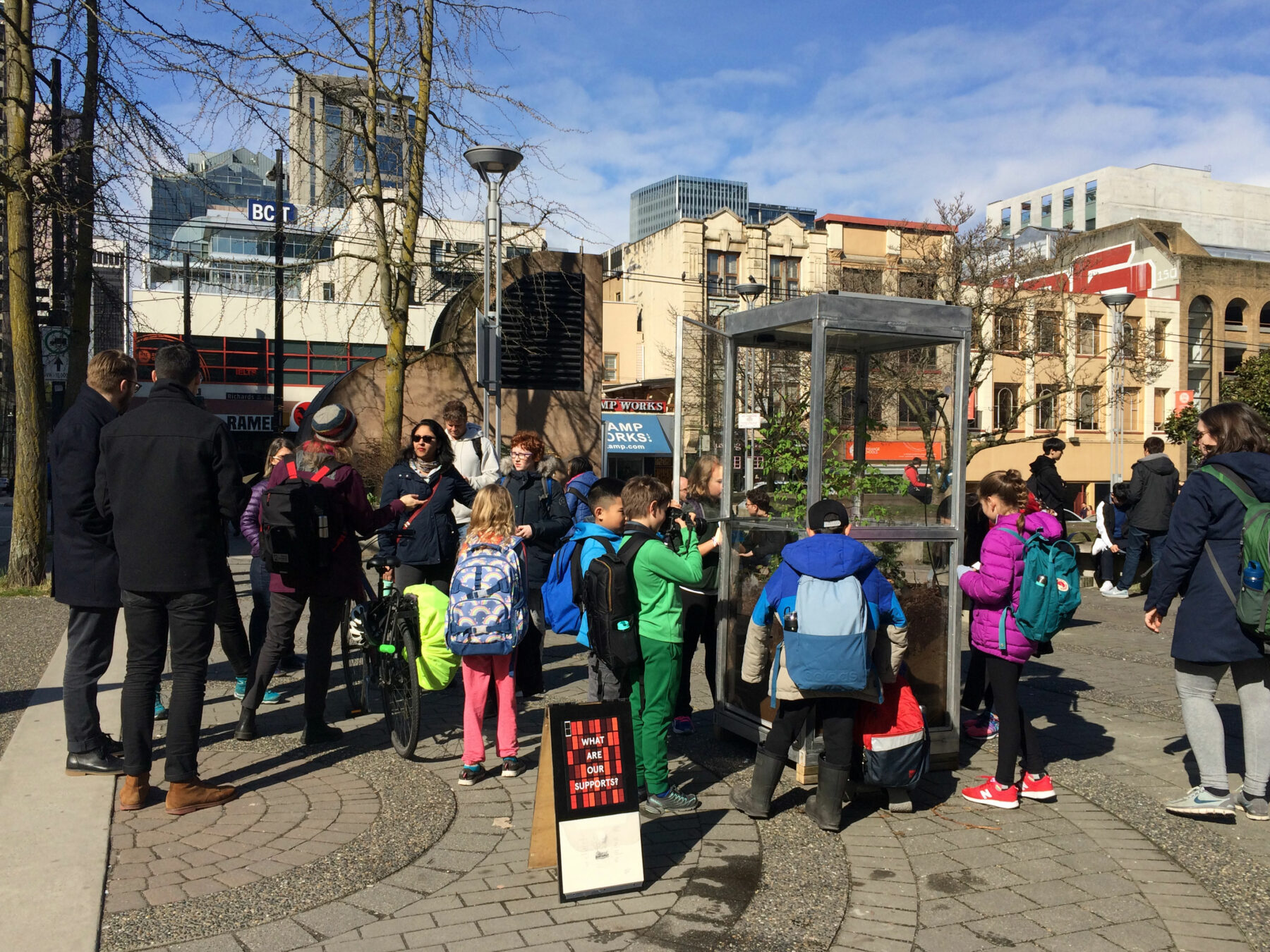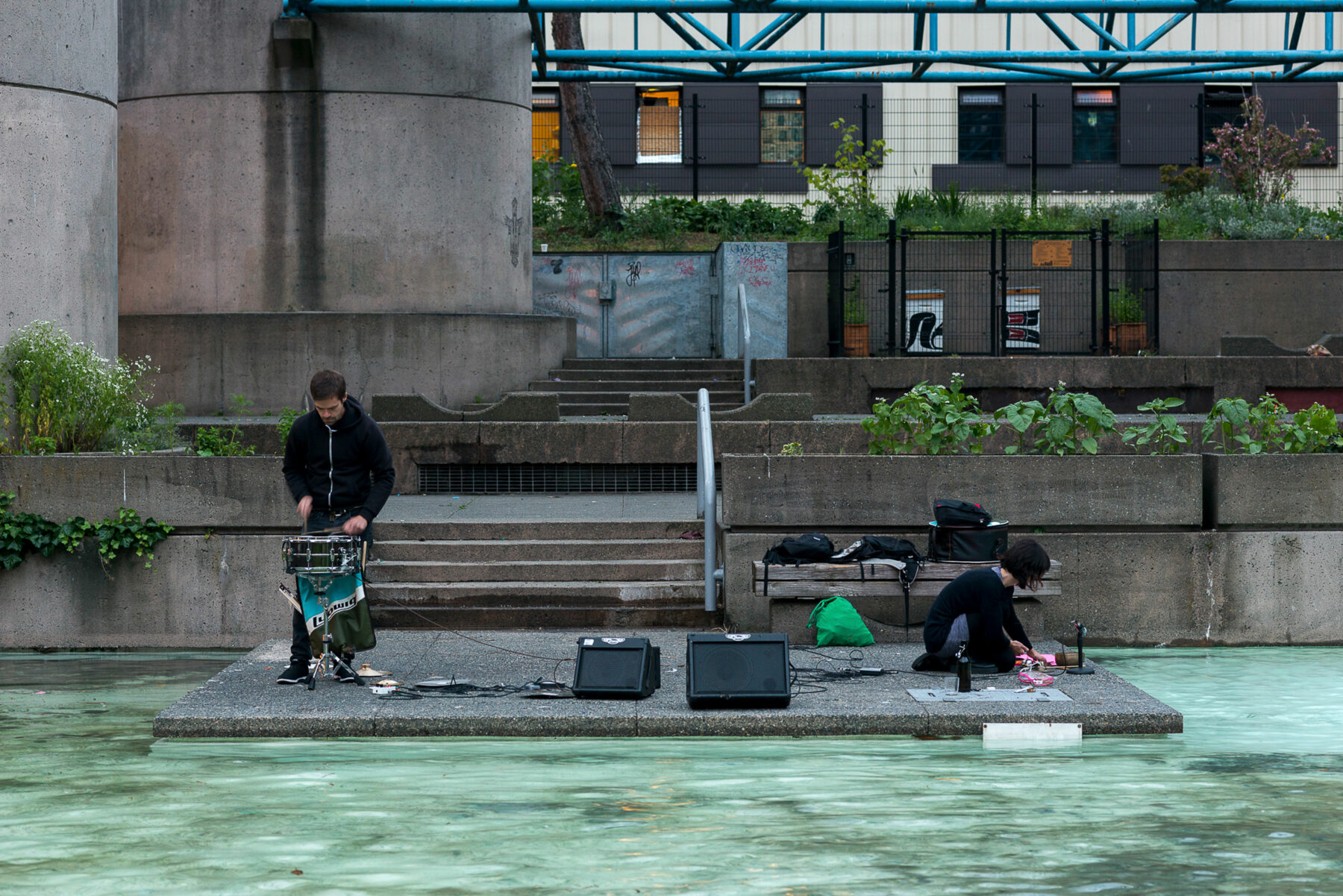
On a hot, dry day at the end of June, quite nearly the birthday of so-called-Canada, I find myself in Cathedral Square Park, at the corner of Dunsmuir and Richards in downtown Vancouver. My visit to the park is precipitated by the invitation to review the book, What Are Our Supports?, an anthology edited by Vancouver-based curator Joni Low and art historian Jeff O’Brien, named for the 2018 series of interactive artist projects curated by Low on the site. The program featured performance works, installations, and interventions, all responding to that moment’s particular set of social, political, economic, and environmental urgencies, and addressing the precarity faced by artists and art communities.
In many ways, What Are Our Supports? offers something of a time capsule for the old normal, ever since the instabilities caused by public health, housing scarcity, and climate crisis kickstarted our new normal. In fact, the anthology was not conceived as part of Supports until the blip caused by 2020’s public health measures afforded the space to reflect on the project. Both the book and the project consider the ways that artists galvanize support structures in their communities, question institutional space, and explore how to produce and sustain the energy to maintain these inquiries. The book has an anterior gaze that allows the team who produced the project to contemplate what ideas and perspectives have outlived their usefulness, meditate on what still works, and ponder what can be renewed. What are our supports? I ruminated on this question as I read.

Cathedral Square hosted five collaborative or collective-made artist projects between February 27 and June 30, 2018, featuring work by Germaine Koh, Aron Louis Cohen, and Russell Gordon; Emily Neufeld and T’uy’t’tanat-Cease Wyss; SF Ho and Elisa Ferrari; DRIL Art Collective, John Brennan, Michelle Helen Mackenzie, and Justin Patterson; and Andrew Lee, Khan Lee, and Francis Cruz. Across these projects, the commons of the park is a binding throughline.
“[W]hat magic occurs when the site [that] reflects the project’s metaphor is inhabited and explored?” Low asks in her introduction.1 As she continues, the park “is itself a support structure.” It is a space of coexistence, one between commercial flows, architectural strategies, and host to a range of visitor traffic, from office workers, to international students, to unhoused communities. Originally constructed for Expo ’86, the once-green space still bears some of the fair’s familiar design markers, resembling a kind of outdoor theatre. A large, pillared dais with a geometric canopy painted in “Expo Ernie” blue overlooks the centrepiece water feature, meant to cool the underground BC Hydro substation that powers downtown, Gastown, and the West End. The park sits across from several international schools, low-income student housing, a few non-descript eateries, and is anchored by the Church of the Holy Rosary. On a busy throughfare that connects East Vancouver with Downtown and West Vancouver, the park nonetheless sits outside of a gentrifying impulse—in neither a “cool” neighbourhood, nor near enough to any central services—while being close to everything.

Low describes Cathedral Square as decrepit, and it very much still is. Five years on, on the other side of a global pandemic with historically aggressive inflation and rising financial insecurity in our midst, 2018 seems like salad days.
On the day of my visit, the park is littered with garbage, home to a smattering of pigeons and rodents. People find shade under a canopy of spindly trees and behind the pillars that serve as canvas to Blanketing the City, an ongoing project with xʷməθkʷəy̓əm (Musqueam) weaver and designer Debra Sparrow and the Vancouver Mural Festival that began the same year as Supports. A photograph of Sparrow’s collaborative mural with Chief Janice George (Sḵwxwú7mesh) and Angela George (səlilwətaɬ), published in the volume, shows the park in 2021, albeit camera ready: several people—possibly mural painters and community members—mill around the stage-like platform as water glistens in the pool underneath, while others eat together on a park bench. It looks nice.
Today the pool is unfilled. Empty coffee cups and old shoes are strewn about its dry floor. Where the grass is green in the image, it is nearly gone when I am there—some clovers push through sandy dirt. A worn city sign from 2017 celebrating the planting of a pollinator garden by local beekeeping non-profit, Hives for Humanities, is fixed to a crooked light fixture—a lapsed initiative to revitalize the park. The garden, meant to line the back edges of the park, is parched and dying, overgrown and abandoned. There are few blooms, though a handful of wild poppies and cornflowers are peppered amongst the cigarette butts and weeds. If the space was forgotten in 2018, as Low describes, today it is all but erased from memory. I think about how strange it is that in the more than twenty years I’ve lived in this city, this is the first moment that I’ve stopped to notice this place.
The term support has multiple meanings. If support is a noun, it can be understood as a thing, a system or network, or an embedded structure. When read as a verb, to support is to bolster, and this can take the form of a variety of protective, encouraging, and stabilizing actions. How does the project conceive of these things and actions, and for what purpose is this support gathered? Whom does it serve?

Across the range of supports documented and expanded on in this book, support is also a place called HMH Boothy, a seven-by-three-by-three-foot structure that was installed in Cathedral Square for the duration of the project and which takes the form of an old phone booth. Constructed by Germaine Koh as part of her ongoing Home Made Home Project (2015–) exploring sustainable and itinerant housing, Boothy housed the project’s five collaborative artworks, calling attention to the way that such a shelter might be used were it a truly public space.
Support is also expressed through action and exchange. Koh and her collaborators, Cohen and Gordon, made a currency exchange trading smelted metals for obsolete or unused appliances. Neufeld and Wyss installed an Indigenous ecosystem in Boothy, containing soil, microbes, insects, and Indigenous medicinal plants inside the aluminum and plexiglass structure. Ho and Ferrari produced an exchange of sound, as did DRIL Collective and their collaborators, responding sonically to the square. Lee, Lee, and Cruz transformed the booth into a hair salon, offering free haircuts to passersby in what was perhaps the most practical project of all, while also providing, as Cruz calls it, a “space for people from different walks of life to tell their stories.”2


The book compiles reflections from the artists on these projects, commissioned essays and poetry, and reprinted work by Anishinaabe writer and artist Leanne Betasamosake Simpson and London/Milan-based artist Céline Condorelli. Of the many offerings, it is Vancouver writer and dance artist Alexa Mardon’s essay, “The City Performs the City,” that I am most drawn to.
Mardon moves between poetry and field notes recording their time spent in Cathedral Square. Mardon’s story is one of encounter: “I was asked to place my body in relation to slow growth and temporary disruptions, under the gaze of the city’s unrelenting development.”3 At one point, the author makes a record of the objects they encounter in the park—
Booth
Plant
Greenhouse
Camera
—noting the ways these objects produce a reactive choreography, whereby intentionally placing one’s body in relation to structures allows them to become more known. Mardon’s text is a record of time spent in the commons. They express a kind of tenderness towards an otherwise neglected area. I have used this text as a model for my own engagement.
Because I cannot encounter the works, I encounter the park. First, via the book, and then, with my body. I wander the stairs and ramps along the dais for the first time, and feel the extreme heat of the pavement under the direct sun. I observe people tucked away having private conversations, stashing bikes and suitcases, feeling like I’ve walked into someone else’s house. I try to locate the pollinator garden but find only a few sprouting flowers. I take a seat on a bench. A park dweller says hello. After a while I cross the street to the church, climb the steps, and poke my head in. I don’t feel comfortable enough to enter, so I stay outside. From here, the park appears dry in every sense: used, no longer green, past its time. And yet it is not without potential. As Mardon writes, “In this place, surrounded by the sonic and social traces of our past, present and future, for better or for worse, we could go anywhere.”4
- What Are Our Supports? ed. Joni Low and Jeff O’Brien (Vancouver/Toronto: Information Office, Doryphore Independent Curators Society, Richmond Art Gallery, Art Metropole, 2022), 11.
- Cruz, 167.
- Mardon, 101.
- Mardon, 104.

